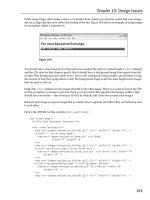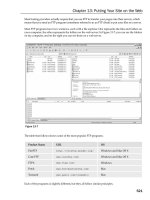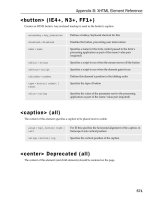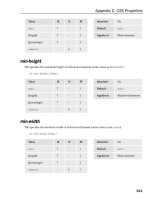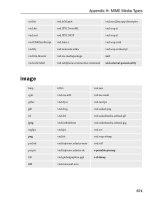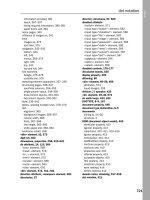CoffeeScript Programming with jQuery, Rails, and Node potx
Bạn đang xem bản rút gọn của tài liệu. Xem và tải ngay bản đầy đủ của tài liệu tại đây (4.15 MB, 140 trang )
www.it-ebooks.info
CoffeeScript Programming with
jQuery, Rails, and Node.js
Learn CoffeeScript programming with the three most
popular web technologies around
Michael Erasmus
BIRMINGHAM - MUMBAI
www.it-ebooks.info
CoffeeScript Programming with jQuery,
Rails, and Node.js
Copyright © 2012 Packt Publishing
All rights reserved. No part of this book may be reproduced, stored in a retrieval
system, or transmitted in any form or by any means, without the prior written
permission of the publisher, except in the case of brief quotations embedded in
critical articles or reviews.
Every effort has been made in the preparation of this book to ensure the accuracy
of the information presented. However, the information contained in this book is
sold without warranty, either express or implied. Neither the author, nor Packt
Publishing, and its dealers and distributors will be held liable for any damages
caused or alleged to be caused directly or indirectly by this book.
Packt Publishing has endeavored to provide trademark information about all of the
companies and products mentioned in this book by the appropriate use of capitals.
However, Packt Publishing cannot guarantee the accuracy of this information.
First published: December 2012
Production Reference: 1061212
Published by Packt Publishing Ltd.
Livery Place
35 Livery Street
Birmingham B3 2PB, UK.
ISBN 978-1-84951-958-8
www.packtpub.com
Cover Image by Abhishek Pandey ()
www.it-ebooks.info
Credits
Author
Michael Erasmus
Reviewers
Stephen Ball
Shreyank Gupta
Acquisition Editor
Mary Jasmine
Commissioning Editor
Meeta Rajani
Technical Editor
Dominic Pereira
Copy Editor
Alda Paiva
Project Coordinator
Shraddha Bagadia
Proofreader
Maria Gould
Indexer
Hemangini Bari
Production Coordinator
Prachali Bhiwandkar
Cover Work
Prachali Bhiwandkar
www.it-ebooks.info
About the Author
Michael Erasmus has been developing software for over 10 years. He has been a
C# programmer for quite a few of them, but has luckily been enlightened enough to
become an open source zealot during the last few years. The most loved tools in his
utility belt are Ruby and Rails, Linux, MongoDB, Vim, jQuery, and CoffeeScript.
He's interested in all manner of science and technology, but tends to dwell on
things such as elegant and eccentric programming languages, machine learning and
statistics, web development, Internet startups, and civic hacking.
He is currently working at
22seven.com, building a service that will help change
people's behavior and do more with the money they have.
When he's not sitting in front of the computer, he likes pulling faces to amuse his
baby son, apologizing to his wonderful wife for sitting in front of a computer all
day, or arguing endlessly with friends, family, colleagues, and random strangers.
He lives near the beach in Muizenberg, Cape Town and loves it.
I would like to thank my wonderful wife for supporting me in
all my crazy endeavors and always being there when things get
tough. Thanks to my employers and colleagues for their support
and feedback. I would also like to express my gratitude to the open
source community in general, and for everyone out there selessly
sharing your work.
www.it-ebooks.info
About the Reviewers
Stephen Ball works for PhishMe Inc. as a full stack Rails developer. He started
programming in BASIC in the 80s and has been tinkering on the Internet since the
early 90s. He's programming for the Web in Perl, PHP, Python, Django, Node.js, and
Rails. He currently writes a Ruby and Rails blog at and a
CoffeeScript blog at . He lives with his wife, Sarah,
and two children, Edward and Marie, in Durham, NC, USA.
Shreyank Gupta is a passout of NIT Durgapur. He works as a programmer
and web developer at Red Hat since 2009. In his free time he works on improving
his photography.
www.it-ebooks.info
www.PacktPub.com
Support les, eBooks, discount offers and more
You might want to visit www.PacktPub.com for support les and downloads related
to your book.
Did you know that Packt offers eBook versions of every book published, with PDF
and ePub les available? You can upgrade to the eBook version at
www.PacktPub.
com
and as a print book customer, you are entitled to a discount on the eBook copy.
Get in touch with us at for more details.
At
www.PacktPub.com, you can also read a collection of free technical articles, sign
up for a range of free newsletters and receive exclusive discounts and offers on Packt
books and eBooks.
Do you need instant solutions to your IT questions? PacktLib is Packt's online
digital book library. Here, you can access, read and search across Packt's entire
library of books.
Why Subscribe?
• Fully searchable across every book published by Packt
• Copy and paste, print and bookmark content
• On demand and accessible via web browser
Free Access for Packt account holders
If you have an account with Packt at www.PacktPub.com, you can use this to access
PacktLib today and view nine entirely free books. Simply use your login credentials
for immediate access.
www.it-ebooks.info
Table of Contents
Preface 1
Chapter 1: Why CoffeeScript? 7
CoffeeScript syntax 8
Semicolons and braces 9
Whitespace 9
Parenthesis 10
CoffeeScript has great function syntax 11
Return isn't required 12
Function arguments 12
Where did the var keyword go? 13
CoffeeScript handles scope better 14
Top level var keywords 15
CoffeeScript has better object syntax 16
Inheritance 17
Overwhelmed? 18
Extending prototypes 18
A few other things CoffeeScript xes 18
Reserved words and object syntax 19
String concatenation 21
Equality 21
The existential operator 22
List comprehensions 24
The while loop 24
Conditional clauses and logical aliases 28
Array slicing and splicing 29
Destructuring or pattern matching 30
=> and @ 33
Switch statements 35
www.it-ebooks.info
Table of Contents
[ ii ]
Chained comparisons 36
Block strings, block comments, and strings 36
Summary 36
Chapter 2: Running CoffeeScript 39
The CoffeeScript stack 39
Node.js and npm 40
Node.js, npm, and CoffeeScript on Windows 41
Installing CoffeeScript on a Mac 44
Using the Apple installer 44
Using Homebrew 46
Installing CoffeeScript with npm 47
Installing CoffeeScript on Linux 48
Ubuntu and MintOS 48
Debian 48
Other distributions 48
Installing CoffeeScript with npm 49
Building Node.js from source 49
Building on Linux or Unix 49
Building on Windows 50
Using CoffeeScript 51
The coffee command 51
The REPL 52
Running .coffee les 52
Compiling to JavaScript 53
Watching 53
Putting it all together 53
Summary 54
Chapter 3: CoffeeScript and jQuery 55
Finding and changing elements 56
The $ function 56
Utility functions 57
Ajax methods 58
Using jQuery 58
Using CoffeeScript and jQuery in the browser 58
Compiling CoffeeScript 58
jQuery and CoffeeScript 59
Testing it all 60
Running a local web server 61
Our application 61
TodoMVC 62
www.it-ebooks.info
Table of Contents
[ iii ]
Our initial HTML 62
Initializing our app 63
Adding a to-do item 64
Using localStorage 64
Displaying the to-do items 66
Showing the to-do items 69
Removing and completing items 70
Now, it's your turn! 71
Summary 71
Chapter 4: CoffeeScript and Rails 73
What makes Rails special? 73
Convention over conguration 73
Don't repeat yourself (DRY) 74
Rails and JavaScript 74
Rails and CoffeeScript 75
Installing Rails 76
Installing Rails using RailsInstaller 76
Installing Rails using RVM 76
Got Rails installed? 77
Developing our Rails application 77
MVC 78
Running our application 78
Our todo_items resource 79
routes.rb 80
The controller 80
The view 81
The CSS 82
Our model 83
Migrations 84
The Rails console 85
Displaying the items in our view using ERB 87
Creating a partial 88
Adding new items 89
Let's try and add a to-do item 90
Adding a CoffeeScript view 91
CoffeeScript in the asset pipeline 91
Completing the to-do items 92
Removing tasks 93
Now, it's your turn 93
Summary 94
www.it-ebooks.info
Table of Contents
[ iv ]
Chapter 5: CoffeeScript and Node.js 95
Node is event-driven 95
Node is fast and scalable 96
Node is not Rails 96
Node and CoffeeScript 96
"Hello World" in Node 96
Express 97
WebSocket 97
Jade 98
Our application 98
Let's get started 98
package.json 99
Installing our modules 99
Creating our app 100
Running our application 100
Creating a view 101
node-supervisor 102
The to-do list view 103
Middleware 104
Our stylesheet 104
The client side 105
Adding collaboration 108
Creating the collaboration UI 108
WebSocket on the client 109
WebSocket on the server 110
Joining a list 111
The UI 112
Leaving a list 114
Testing it all 115
Adding to-do items to a shared list 116
Removing to-do items from a shared list 118
Now, it's your turn 120
Summary 120
Index 121
www.it-ebooks.info
Preface
JavaScript is a quirky little language that was written by Brendan Eich when he
was working at Netscape around 1995. It was the rst browser-based scripting
language and ran only in Netscape Navigator at the time, but it eventually found
its way into most other web browsers. Back then, web pages consisted almost
entirely of static markup. JavaScript (initially named LiveScript) emerged around
the need to make pages dynamic and to bring the power of a full scripting
language to browser developers.
A lot of the design decisions of the language were driven by the need of simplicity
and ease of use, although at the time, some were made for pure marketing reasons
at Netscape. The name "JavaScript" was chosen to associate it with Java from Sun
Microsystems, despite the fact that Sun really had nothing to do with it and that it's
conceptually quite different from its namesake.
Except in one way, that is, most of its syntax was borrowed from Java, and also
C and C++, so as to be familiar to the programmers coming from these languages.
But despite looking similar, it is in fact a very different beast under the hood and
shares characteristics with the more exotic languages such as Self, Scheme, and
Smalltalk. Among these are dynamic typing, prototypical inheritance, rst class
functions, and closures.
So we ended up with a language that looked a lot like some of the mainstream
languages at the time and could be coaxed into acting a lot like them, but with quite
different central ideas. This has caused it to be very misunderstood for many years.
A lot of programmers never saw it as being a "serious" programming language and
thus didn't apply a lot of the best development practices built up over decades when
it came to writing browser code.
Those who did delve further into the language were sure to nd a lot of strangeness.
Eich himself admitted that the language was prototyped within about 10 days, and
even though what he came up with was impressive, JavaScript isn't without (many)
warts. These too didn't really help to raise its prole.
www.it-ebooks.info
Preface
[ 2 ]
Despite all these issues, JavaScript still became one of the most widely used
programming languages in the world, if not merely because of the explosion of the
Internet and the spread of web browsers. Support across a multitude of browsers
would seem to be a great thing, but it also caused havoc because of differences in
implementations, both in the language and the DOM.
Around 2005, the term AJAX was coined to describe a style of JavaScript
programming that was made possible by the introduction of the
XMLHTTPRequest
object in browsers. This meant that developers could write client-side code that
could communicate with the server using HTTP directly, and update page elements
without reloading the page. This was really a turning point in the history of the
language. All of a sudden, it was being used in "serious" web applications, and
people began to see the language in a different light.
In 2006, John Resig released jQuery to the world. It was designed to simplify client-
side scripting, DOM manipulation, and AJAX, as well as to abstract away many of
the inconsistencies across browsers. It became an essential tool for many JavaScript
programmers. To date, it is used on 55 percent of the top 10, 000 websites in the world.
In 2009, Ryan Dahl created Node.js, an event-driven network application framework
written on top of the Google V8 JavaScript engine. It quickly became very popular,
especially for writing web server applications. A big factor in its success has been the
fact that you could now write JavaScript on the server, as well as in the browser. An
elaborate and distinguished community has sprung up around the framework, and
at present the future of Node.js is looking very bright.
Early in 2010, Jeremy Ashkenas created CoffeeScript, a language that compiles to
JavaScript. Its goal is to create cleaner, more concise, and more idiomatic JavaScript
and to make it easier to use the better features and patterns of the language. It does
away with a lot of the syntactic cruft of JavaScript, reducing the line noise and
generally creating much shorter and clearer code.
Inuenced by languages such as Ruby, Python, and Haskell, it borrows some of the
powerful and interesting features of these languages. Although it can look quite
different, the CoffeeScript code generally maps to its generated JavaScript pretty
closely. It has grown to be an overnight success, quickly being adopted by the Node.
js community as well as being included in Ruby on Rails 3.1.
Brendan Eich has also expressed his admiration for CoffeeScript, and has used it as an
example of some of the things he would like to see in the future versions of JavaScript.
This book serves as an introduction to the language as well as a motivation for why
you should write CoffeeScript instead of JavaScript wherever you can. It also then
explores using CoffeeScript in the browser using jQuery and Ruby on Rails, as well
as on the server using Node.js.
www.it-ebooks.info
Preface
[ 3 ]
What this book covers
Chapter 1, Why CoffeeScript?, introduces CoffeeScript and delves deeper into the
differences between it and JavaScript, specically focusing on the parts of JavaScript
that CoffeeScript aims to improve.
Chapter 2, Running CoffeeScript, goes into a short introduction of the CoffeeScript
stack and how it's typically packaged. You will learn how to install CoffeeScript
on Windows, Mac, and Linux using Node.js and npm. You will get to know the
CoffeeScript compiler (
coffee) as well as get familiar with some helpful tools and
resources for day-to-day development in CoffeeScript.
Chapter 3, CoffeeScript and jQuery, introduces client-side development using jQuery
and CoffeeScript. We also start implementing a sample application for this book
using these technologies.
Chapter 4, CoffeeScript and Rails, starts with a brief overview of Ruby on Rails, and its
history with JavaScript frameworks. We are introduced to the Asset Pipeline in Rails
3.1 and how it integrates with CoffeeScript and jQuery. We then move to adding a
backend to our sample application using Rails.
Chapter 5, CoffeeScript and Node.js, starts with a brief overview of Node.js, its history,
and philosophy. It then demonstrates how easy it is to write server-side code
in CoffeeScript using Node.js. We then implement the nal piece of the sample
application using WebSockets and Node.js.
What you need for this book
To use this book, you need a computer running Windows, Mac OS X, or Linux and a
basic text editor. Throughout the book, we'll be downloading some software that we
need from the Internet, all of which will be free and open source.
Who this book is for
This book is for existing JavaScript programmers who would like to learn more
about CoffeeScript, or someone who has some programming experience and
would like to learn more about web development using CoffeeScript. It also serves
as a great introduction to jQuery, Ruby on Rails, and Node.js. Even if you have
experience with one or more of these frameworks, this book will show you how
you can use CoffeeScript to make your experiences with them even better.
www.it-ebooks.info
Preface
[ 4 ]
Conventions
In this book, you will nd a number of styles of text that distinguish between
different kinds of information. Here are some examples of these styles, and an
explanation of their meaning.
Code words in text are shown as follows: "You'll see that the clause of the
if
statement does not need be enclosed within parentheses".
A block of code is set as follows:
gpaScoreAverage = (scores ) ->
total = scores.reduce (a, b) -> a + b
total / scores.length
When we wish to draw your attention to a particular part of a code block,
the relevant lines or items are set in bold:
create: (e) ->
$input = $(event.target)
val = ($.trim $input.val())
Any command-line input or output is written as follows:
coffee -co public/js -w src/
New terms and important words are shown in bold. Words that you see on
the screen, in menus or dialog boxes for example, appear in the text like this:
"a footer will have the Clear completed button".
Warnings or important notes appear in a box like this.
Tips and tricks appear like this.
Reader feedback
Feedback from our readers is always welcome. Let us know what you think about
this book—what you liked or may have disliked. Reader feedback is important for
us to develop titles that you really get the most out of.
www.it-ebooks.info
Preface
[ 5 ]
To send us general feedback, simply send an e-mail to ,
and mention the book title via the subject of your message.
If there is a topic that you have expertise in and you are interested in either writing
or contributing to a book, see our author guide on
www.packtpub.com/authors.
Customer support
Now that you are the proud owner of a Packt book, we have a number of things
to help you to get the most from your purchase.
Downloading the example code
You can download the example code les for all Packt books you have purchased
from your account at . If you purchased this book
elsewhere, you can visit and register to
have the les e-mailed directly to you.
Errata
Although we have taken every care to ensure the accuracy of our content, mistakes
do happen. If you nd a mistake in one of our books—maybe a mistake in the text or
the code—we would be grateful if you would report this to us. By doing so, you can
save other readers from frustration and help us improve subsequent versions of this
book. If you nd any errata, please report them by visiting ktpub.
com/support
, selecting your book, clicking on the errata submission form link, and
entering the details of your errata. Once your errata are veried, your submission
will be accepted and the errata will be uploaded on our website, or added to any list
of existing errata, under the Errata section of that title. Any existing errata can be
viewed by selecting your title from />Piracy
Piracy of copyright material on the Internet is an ongoing problem across all media.
At Packt, we take the protection of our copyright and licenses very seriously. If you
come across any illegal copies of our works, in any form, on the Internet, please
provide us with the location address or website name immediately so that we can
pursue a remedy.
www.it-ebooks.info
Preface
[ 6 ]
Please contact us at with a link to the suspected
pirated material.
We appreciate your help in protecting our authors, and our ability to bring you
valuable content.
Questions
You can contact us at if you are having a problem
with any aspect of the book, and we will do our best to address it.
www.it-ebooks.info
Why CoffeeScript?
CoffeeScript compiles to JavaScript and follows its idioms closely. It's quite possible
to rewrite any CoffeeScript code in Javascript and it won't look drastically different.
So why would you want to use CoffeeScript?
As an experienced JavaScript programmer, you might think that learning a completely
new language is simply not worth the time and effort.
But ultimately, code is for programmers. The compiler doesn't care how the code
looks or how clear its meaning is; either it will run or it won't. We aim to write
expressive code as programmers so that we can read, reference, understand,
modify, and rewrite it.
If the code is too complex or lled with needless ceremony, it will be harder to
understand and maintain. CoffeeScript gives us an advantage to clarify our ideas
and write more readable code.
It's a misconception to think that CoffeeScript is very different from JavaScript. There
might be some drastic syntax differences here and there, but in essence, CoffeeScript
was designed to polish the rough edges of JavaScript to reveal the beautiful language
hidden beneath. It steers programmers towards JavaScript's so-called "good parts"
and holds strong opinions of what constitutes good JavaScript.
One of the mantras of the CoffeeScript community is: "It's just JavaScript", and I have
also found that the best way to truly comprehend the language is to look at how it
generates its output, which is actually quite readable and understandable code.
Throughout this chapter, we'll highlight some of the differences between the two
languages, often focusing on the things in JavaScript that CoffeeScript tries to improve.
www.it-ebooks.info
Why CoffeeScript?
[ 8 ]
In this way, I would not only like to give you an overview of the major features of
the language, but also prepare you to be able to debug your CoffeeScript from its
generated code once you start using it more often, as well as being able to convert
existing JavaScript.
Let's start with some of the things CoffeeScript xes in JavaScript.
CoffeeScript syntax
One of the great things about CoffeeScript is that you tend to write much shorter
and more succinct programs than you normally would in JavaScript. Some of this
is because of the powerful features added to the language, but it also makes a few
tweaks to the general syntax of JavaScript to transform it to something quite elegant.
It does away with all the semicolons, braces, and other cruft that usually contributes
to a lot of the "line noise" in JavaScript.
To illustrate this, let's look at an example. On the left-hand side of the following
table is CoffeeScript; on the right-hand side is the generated JavaScript:
CoffeeScript JavaScript
fibonacci = (n) ->
return 0 if n == 0
return 1 if n == 1
(fibonacci n-1) +
(fibonacci n-2)
alert fibonacci 10
var fibonacci;
fibonacci = function(n) {
if (n === 0) {
return 0;
}
if (n === 1) {
return 1;
}
return (fibonacci(n - 1))
+ (fibonacci(n - 2));
};
alert(fibonacci(10));
To run the code examples in this chapter, you can use the great Try CoffeeScript
online tool, at . It allows you to type in CoffeeScript
code, which will then display the equivalent JavaScript in a side pane. You can
also run the code right from the browser (by clicking the Run button in the
upper-left corner). If you prefer to get CoffeeScript running on your computer
to run the samples rst, skip to the next chapter and then come back once you
have CoffeeScript installed. This tool is shown in the following screenshot:
www.it-ebooks.info
Chapter 1
[ 9 ]
At rst, the two languages might appear to be quite drastically different, but
hopefully as we go through the differences, you'll see that it's all still JavaScript
with some small tweaks and a lot of nice syntactical sugar.
Semicolons and braces
As you might have noticed, CoffeeScript does away with all the trailing semicolons at
the end of a line. You can still use a semicolon if you want to put two expressions on a
single line. It also does away with enclosing braces (also known as curly brackets) for
code blocks such as if statements, switch, and the try catch block.
Whitespace
You might be wondering how the parser gures out where your code blocks start
and end. The CoffeeScript compiler does this by using syntactical whitespace. This
means that indentation is used for delimited code blocks instead of braces.
This is perhaps one of the most controversial features of the language. If you think
about it, in almost all languages, programmers tend to already use indentation of
code blocks to improve readability, so why not make it part of the syntax? This is
not a new concept, and was mostly borrowed from Python. If you have any
experience with signicant whitespace language, you will not have any trouble
with CoffeeScript indentation.
www.it-ebooks.info
Why CoffeeScript?
[ 10 ]
If you don't, it might take some getting used to, but it makes for code that is
wonderfully readable and easy to scan, while shaving off quite a few keystrokes.
I'm willing to bet that if you do take the time to get over some initial reservations
you might have, you might just grow to love block indentation.
Blocks can be indented with tabs or spaces, but be careful about
being consistent using one or the other, or CoffeeScript will not
be able to parse your code correctly.
Parenthesis
You'll see that the clause of the if statement does not need be enclosed within
parentheses. The same goes for the alert function; you'll see that the single string
parameter follows the function call without parentheses as well. In CoffeeScript,
parentheses are optional in function calls with parameters, clauses for if else
statements, as well as while loops.
Although functions with arguments do not need parentheses, it is still a good idea
to use them in cases where ambiguity might exist. The CoffeeScript community has
come up with a nice idiom: wrapping the whole function call in parenthesis. The use
of the
alert function in CoffeeScript is shown in the following table:
CoffeeScript JavaScript
alert square 2 * 2.5 + 1
alert (square 2 * 2.5) + 1
alert(square(2 * 2.5 + 1));
alert((square(2 * 2.5)) + 1);
Functions are rst class objects in JavaScript. This means that when you refer
to a function without parentheses, it will return the function itself, as a value.
Thus, in CoffeeScript you still need to add parentheses when calling a function
with no arguments.
By making these few tweaks to the syntax of JavaScript, CoffeeScript arguably
already improves the readability and succinctness of your code by a big factor,
and also saves you quite a lot of keystrokes.
But it has a few other tricks up its sleeve. Most programmers who have written a
fair amount of JavaScript would probably agree that one of the phrases that gets
typed the most frequently would have to be the function denition
function(){}.
Functions are really at the heart of JavaScript, yet not without its many warts.
www.it-ebooks.info
Chapter 1
[ 11 ]
CoffeeScript has great function syntax
The fact that you can treat functions as rst class objects as well as being able to
create anonymous functions is one of JavaScript's most powerful features. However,
the syntax can be very awkward and make the code hard to read (especially if
you start nesting functions). But CoffeeScript has a x for this. Have a look at the
following snippets:
CoffeeScript JavaScript
-> alert 'hi there!'
square = (n) -> n * n
var square;
(function() {
return alert('hi there!');
});
square = function(n) {
return n * n;
};
Here, we are creating two anonymous functions, the rst just displays a dialog and
the second will return the square of its argument. You've probably noticed the funny
-> symbol and might have gured out what it does. Yep, that is how you dene
a function in CoffeeScript. I have come across a couple of different names for the
symbol but the most accepted term seems to be a thin arrow or just an arrow. This
is as opposed to the fat arrow, which we'll discuss later.
Notice that the rst function denition has no arguments and thus we can drop the
parenthesis. The second function does have a single argument, which is enclosed in
parenthesis, which goes in front of the
-> symbol. With what we now know, we can
formulate a few simple substitution rules to convert JavaScript function declarations
to CoffeeScript. They are as follows:
• Replace the
function keyword with ->
• If the function has no arguments, drop the parenthesis
• If it has arguments, move the whole argument list with parenthesis in front
of the
-> symbol
• Make sure that the function body is properly indented and then drop the
enclosing braces
www.it-ebooks.info
Why CoffeeScript?
[ 12 ]
Return isn't required
You might have noted that in both the functions, we left out the return keyword.
By default, CoffeeScript will return the last expression in your function. It will try
to do this in all the paths of execution. CoffeeScript will try turning any statement
(fragment of code that returns nothing) into an expression that returns a value.
CoffeeScript programmers will often refer to this feature of the language by saying
that everything is an expression.
This means you don't need to type
return anymore, but keep in mind that this can,
in many cases, alter your code subtly, because of the fact that you will always return
something. If you need to return a value from a function before the last statement,
you can still use
return.
Function arguments
Function arguments can also take an optional default value. In the following code
snippet you'll see that the optional value specied is assigned in the body of the
generated Javascript:
CoffeeScript JavaScript
square = (n=1) ->
alert(n * n)
var square;
square = function(n) {
if (n == null) {
n = 1;
}
return alert(n * n);
};
In JavaScript, each function has an array-like structure called arguments with
an indexed property for each argument that was passed to the function. You can
use arguments to pass in a variable number of parameters to a function. Each
parameter will be an element in arguments and thus you don't have to refer to
parameters by name.
Although the
arguments object acts somewhat like an array, it is in not in fact a
"real" array and lacks most of the standard array methods. Often, you'll nd that
arguments doesn't provide the functionality needed to inspect and manipulate its
elements like they are used with an array.
www.it-ebooks.info
Chapter 1
[ 13 ]
This has forced many programmers to use a hack by making Array.prototype.
slice
copy the argument object elements, or to use the jQuery.makeArray method
to create a standard array, which can then be used like normal.
CoffeeScript borrows this pattern of creating an array from arguments that are
represented by splats, denoted with three dots (
). These are shown in the
following code snippet:
CoffeeScript:
gpaScoreAverage = (scores ) ->
total = scores.reduce (a, b) -> a + b
total / scores.length
alert gpaScoreAverage(65,78,81)
scores = [78, 75, 79]
alert gpaScoreAverage(scores )
JavaScript:
var gpaScoreAverage, scores,
__slice = [].slice;
gpaScoreAverage = function() {
var scores, total;
scores = 1 <= arguments.length ? __slice.call(arguments, 0) : [];
total = scores.reduce(function(a, b) {
return a + b;
});
return total / scores.length;
};
alert(gpaScoreAverage(65, 78, 81));
scores = [78, 75, 79];
alert(gpaScoreAverage.apply(null, scores));
Notice that in the function denition, the parameter is followed by This
tells CoffeeScript to allow for variable arguments. The function can then be
invoked using either a list of parameters or an array followed by
Where did the var keyword go?
In JavaScript, you create local variables by prexing their declarations with
a var keyword. If you omit it, the variable will be created in the global scope.
www.it-ebooks.info
Why CoffeeScript?
[ 14 ]
You'll see throughout these examples that that we didn't need to use the var
keyword, and that CoffeeScript created the actual variable declarations at the
top of the function in the generated JavaScript.
If you're an experienced JavaScripter, you might be wondering how you would
then go about creating global variables. The simple answer is you can't.
Many people (probably including the authors of CoffeeScript) would argue that
this is a good thing, because in most cases global variables should be avoided.
Don't fret though, as there are ways to create top-level objects that we'll get to
in a moment. But this does lead us neatly onto another benet of CoffeeScript.
CoffeeScript handles scope better
Take a look at the following snippet of JavaScript. Notice that a variable called
salutation gets dened in two places, inside the function, as well as after the
function gets called the rst time:
JavaScript
var greet = function(){
if(typeof salutation === 'undefined')
salutation = 'Hi!';
console.log(salutation);
}
greet();
salutation = "Bye!";
greet();
In JavaScript, when you omit the var keyword while declaring a variable, it
immediately becomes a global variable. Global variables are available in all
scopes, and thus can be overwritten from anywhere, which often ends up as
being a mess.
In the previous example, the
greet function rst checks if the salutation variable
is dened (by checking if typeof equals undefined, a common workaround to see
if a variable is dened in JavaScript). If it has not been dened previously, it creates
it without a var keyword. This will immediately promote the variable to the global
scope. We can see the consequences of this in the rest of the snippet.
The rst time the
greet function is called, the string Hi! will be logged. After the
salutation has been changed and the function is called again, the console will instead
log Bye!. Because the variable was leaked to be a global variable, its value was
overwritten outside of the function scope.
www.it-ebooks.info

